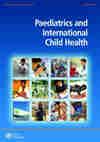母亲抑郁和婴儿社交退缩作为3.5岁纵向艾滋病毒感染儿童行为和发展的预测因素
IF 1.4
4区 医学
Q3 PEDIATRICS
引用次数: 1
摘要
摘要背景在低收入和中等收入国家,产后抑郁症的患病率很高,而且往往与艾滋病毒状况有关。母亲的抑郁症会对母亲的养育产生负面影响,并可能导致婴儿社交退缩。母亲的抑郁和婴儿的社交退缩会对儿童的行为和神经发育轨迹产生有害的长期影响。目的探讨产后10-12个月的母亲抑郁和婴儿社交退缩是否是42个月时儿童行为和发育的重要预测因素。方法采用前瞻性纵向设计,对74对感染艾滋病毒的母婴二人组进行随访。使用流行病学研究中心抑郁量表(CES-D)对母亲进行抑郁评估。婴儿社交退缩采用改良的警报-痛苦婴儿量表(m-ADBB)进行评估,发育和行为分别采用格里菲斯心理发展量表(GMDS)和儿童行为检查表(CBCL)进行评估。结果母亲抑郁解释了4.8%的儿童行为差异(β=0.98,t=2.05,p<0.05)和10.3%的发育差异(β=-0.30,t=-2.66,p<0.05)。婴儿社交退缩不是行为的显著预测因素(β=3.27,t=1.36,p=0.18),但它确实独特地解释了7%的发育差异(β=−1.32,t=−2.48,p<0.05)。结论在艾滋病毒的背景下,筛查母亲抑郁和母婴互动的质量很重要(尤其是在产后第一年),因为它们对行为和神经发育有着重大的长期影响。缩写ANOVA:方差分析;ART:抗逆转录病毒疗法;CBCL:儿童行为检查表;流行病学研究中心抑郁量表;CHEI:接触和感染艾滋病毒的儿童;CHER:儿童艾滋病早期抗逆转录病毒治疗试验;CHEU:接触和未感染艾滋病毒的儿童;朱:未接触和未感染艾滋病病毒的儿童;格里菲斯心理发展量表;艾滋病毒:人体免疫缺陷病毒;LMIC:低收入和中等收入国家;m-ADBB:改良型婴儿遇险报警量表;NRF:国家研究基金会;南非医学研究委员会;世界卫生组织:世界卫生组织本文章由计算机程序翻译,如有差异,请以英文原文为准。
Maternal depression and infant social withdrawal as predictors of behaviour and development in vertically HIV-infected children at 3.5 years
ABSTRACT Background In low- and middle-income countries, there is a high prevalence of post-partum depression and it is often associated with HIV status. Maternal depression negatively affects mothering and can lead to social withdrawal in infants. Maternal depression and infant social withdrawal can have deleterious long-term effects on children’s behaviour and neurodevelopmental trajectories. Aim To investigate whether maternal depression and infant social withdrawal at 10–12 months post-partum were significant predictors of child behaviour and development at 42 months. Method Seventy-four mother–infant dyads living with HIV were followed in a prospective, longitudinal design. Mothers were assessed for depression using the Center for Epidemiologic Studies Depression scale (CES-D). Infant social withdrawal was assessed by the modified Alarm Distress Baby Scale (m-ADBB), and development and behaviour were evaluated by the Griffiths Mental Development Scales (GMDS) and the Child Behavior Checklist (CBCL), respectively. Results Maternal depression explained 4.8% of the variance in child behaviour (β = 0.98, t = 2.05, p < 0.05) and 10.3% of the variance in development (β = −0.30, t = −2.66, p < 0.05). Infant social withdrawal was not a significant predictor of behaviour (β = 3.27, t = 1.36, p = 0.18), but it did uniquely explain 7% of the variance in development (β = −1.32, t = −2.48, p < 0.05). Conclusion In the context of HIV, screening for maternal depression and the quality of mother–infant interactions are important (especially in the 1st year post-partum), given the significant long-term impact they have on behaviour and neurodevelopment. Abbreviations ANOVA: analysis of variance; ART: antiretroviral therapy; CBCL: Child Behavioral Checklist; CES-D: Center for Epidemiologic Studies Depression Scale; CHEI: children HIV-exposed and infected; CHER: Children with HIV Early Antiretroviral Treatment Trial; CHEU: children HIV-exposed and uninfected; CHUU: children HIV-unexposed and -uninfected; GMDS: Griffiths Mental Development Scales; HIV: human immunodeficiency virus; LMIC: low- and middle-income countries; m-ADBB: modified Alarm Distress Baby Scale; NRF: National Research Foundation; SAMRC: South African Medical Research Council; WHO: World Health Organization
求助全文
通过发布文献求助,成功后即可免费获取论文全文。
去求助
来源期刊

Paediatrics and International Child Health
PEDIATRICS-
CiteScore
3.30
自引率
0.00%
发文量
19
审稿时长
6-12 weeks
期刊介绍:
Paediatrics and International Child Health is an international forum for all aspects of paediatrics and child health in developing and low-income countries. The international, peer-reviewed papers cover a wide range of diseases in childhood and examine the social and cultural settings in which they occur. Although the main aim is to enable authors in developing and low-income countries to publish internationally, it also accepts relevant papers from industrialised countries. The journal is a key publication for all with an interest in paediatric health in low-resource settings.
 求助内容:
求助内容: 应助结果提醒方式:
应助结果提醒方式:


